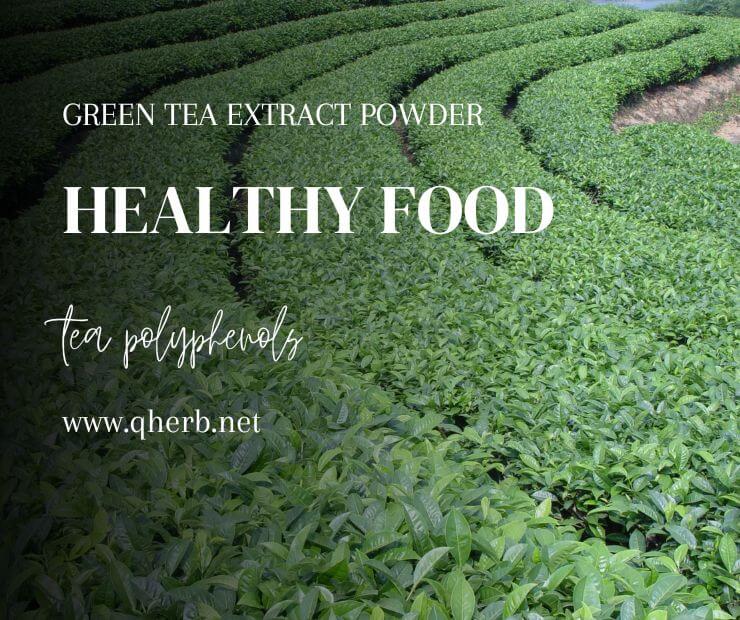Green tea extract powder is the active ingredient extracted from tea leaves, including tea polyphenols (catechins), caffeine, aromatic oils, minerals, pigments, carbohydrates, proteins, amino acids, vitamins, etc.
What is tea polyphenol:
Tea polyphenols have antioxidant and free radical scavenging effects, significantly reduce total serum cholesterol, triglyceride, and low-density lipoprotein cholesterol levels in hyperlipidemia, and simultaneously have the effect of restoring and protecting vascular endothelial function. The hypolipidemic effect of tea polyphenols is also one of the main reasons tea can make obese people lose weight without rebounding.
The Composition of tea polyphenols
Tea polyphenols (Green Tea Polyphenols, GTP) are the main components of green tea, accounting for about 30% of the dry matter. GTP is extracted from tea leaves and their by-products (tea powder, tea flakes, crude tea, or trimmed leaves). Since it is only extracted with food-grade ethyl acetate, the original structure of GTP is retained, and the product is light yellow powder. The main components are catechins, accounting for about 60% ~ 80% of the total GTP, including 4% ~ 6% epicatechin (L-EC), 6% ~ 8% epigallocatechin (DL-EC), 10% ~ 15% epigallocatechin (L-EGC), 50% ~ 60% epigallocatechin gallate (L-ECG), and 8% ~ 10% caffeine. The GTP structure is rich in phenolic hydroxyl groups, which can provide active hydrogen to inactivate free radicals. The free radicals formed by oxidation have high stability due to the catechol structure. Therefore, GTP has the effect of scavenging free radicals and inhibiting lipid peroxidation.
Food application of green tea extract powder
Green tea extract powder has been widely used as a natural antioxidant in the food industry. According to the Chinese food additive use standard, tea polyphenols can be used in foods such as oil, moon cakes, and ham, and the dosage is 0.4g/kg. The method is first to dissolve it in ethanol, add a certain amount of citric acid to make a solution, and then use it for food by spraying or adding.
Meat products:
During the storage period, meat and its effects often turn yellow due to the automatic oxidation of fat and a rancid taste. In processing meat products, soaking or spraying various meat products with the prepared tea polyphenol solution can make the protein on the surface of meat products, and tea polyphenols form an impermeable hard film. To achieve the excellent effect of inhibiting oxidative rancidity and bacterial growth on the surface of meat products and preventing corruption.
Edible animal and vegetable fats and oils: Animal fats are easily oxidized and deteriorate because they do not contain natural antioxidants. Adding tea polyphenols to oils can prevent and delay the automatic oxidative decomposition of unsaturated fatty acids, effectively inhibit the oxidative rancidity of fats, and prolong their storage period.
Fried food:
During the frying process, the color of fried food becomes darker and blacker due to oxidation; during storage, with the gradual deepening of the oxidative rancidity of the oil, the aroma and flavor of the product are seriously affected. The antioxidant effect of tea polyphenols on fried food is better, which can delay oxidative rancidity and improve the shelf life of food.
Baked food:
In the production of moon cakes and other oil-containing foods, adding tea polyphenols to the mixture of flour and oil-containing items can solve the preservatives of these foods, play a role in nutrition and health care, and enhance food flavor.
Aquatic products:
Green tea extract powder Tea polyphenols have significant anti-oxidation, anti-corruption, anti-browning, and other effects in preserving and processing fish, shrimp, and other aquatic products. When making dried fish products, soaking marine products in water containing tea polyphenols can prevent the dried fish from turning yellow and lipid oxidation caused by “oil burning.” When freezing fresh fish, adding tea polyphenol preparations can improve fish preservation.
Beverages:
Tea polyphenols can be used to prepare various tea beverages and applied to multiple alcoholic drinks. They can also inhibit the destruction of vitamins A and C in beverages such as soy milk, soft drinks, and juices, thereby protecting the beverages. Various nutrients.
Candy food:
Tea polyphenols can be used in chewing gum, center-filled candy, fruit candy, and other candies, which can effectively resist oxidation, preserve freshness, fix color and fragrance, and remove bad breath. In addition, tea polyphenols can also make the “acid tail” in high-sugar foods disappear, making the taste sweet and refreshing.








